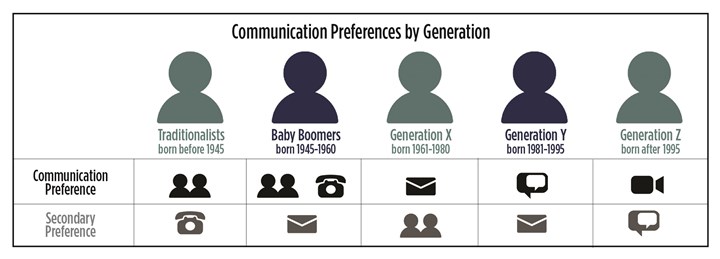Effective Communication: Who
The answer to “Who” isn’t just a name — it’s a person. Discover the different communication preferences for each generation.
In the last issue of Production Machining, we looked into the overall decision-making for effective communication: determining Who, What, Where, When, Why and How Many helps determine the How to communicate. So is the Who just a name? No. The Who is a person, and since the first rule of communicating is to consider your audience, the person’s preference should be considered.
When trying to decide the best communication method with which to communicate, a relatively easy factor to consider is the generation to which your audience belongs. According to Forbes’ “The Business Leader’s Guide to Communication Across Generations,” there are general communication preferences for each generation.

Traditionalists (born before 1945): Most Traditionalists are enjoying retirement, however, there are a few for whom retirement is unwelcome and they are still part of the workforce. Traditionalists used rotary dial phones and put letters in the mail. They prefer face-to-face communication.
Baby Boomers (born between 1945-1960): Baby Boomers have seen a lot of changes on the communication front. They still prefer phone calls and face-to-face, but have embraced email as a form of communication.
Generation X (born between 1961-1980): Generation X (or Gen Xers) was the first generation to see a boom in double income households and are considered the “latch key” generation. Generation X prefers email for communication and doesn’t mind face-to-face as long as it warrants a face-to-face conversation.
Generation Y (born between 1981-1995): Generation Y — more commonly known as millennials — grew up on the internet and were the social media natives. They prefer to text above all, but will use email in a business setting.
Generation Z (born after 1995): Communication for Generation Z is digital, digital, digital. Their preferred method of communication is face-to-face via video (for example, Facetime and Skype). Because they are just entering the workforce, they will have to use email — the preference of their Baby Boomer and Generation X bosses — but don’t be surprised if video calls are commonplace in business when Generation Z starts to lead.
About the Author
Carli Kistler-Miller, MBA has over 20 years of experience with communications, event/meeting planning, marketing, writing and operations. Email cmiller@pmpa.org.
Related Content
-
Craftsman Cribsheet No. 121: ISO Turning — What Does it All Mean?
How to make sense of all those different letters and numbers in ISO turning inserts.
-
Keeping It In The Family — Succession Tips From Those Who Lived It | Part 1
PMPA members share some tips to avoid getting burned when passing the business torch from one family member to another.
-
Cold-Drawn Steel Barstock: How It Is Manufactured, Benefits to Your Shop
Understanding the benefits provided by cold-drawn steel barstock can help you optimize the work you quote by maximizing benefits to your manufacturing process and customer.








.jpg;maxWidth=300;quality=90)


.jpg;maxWidth=300;quality=90)



